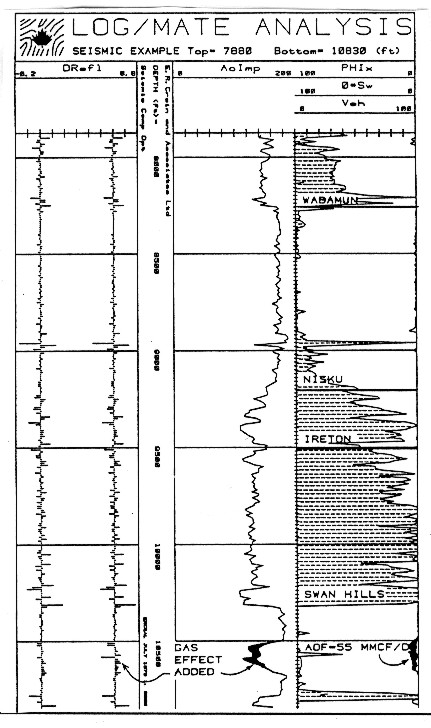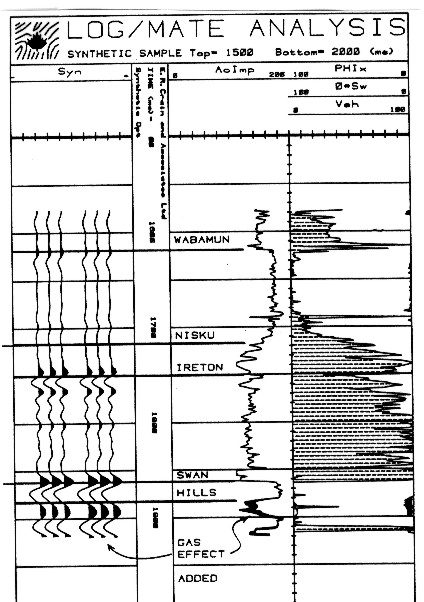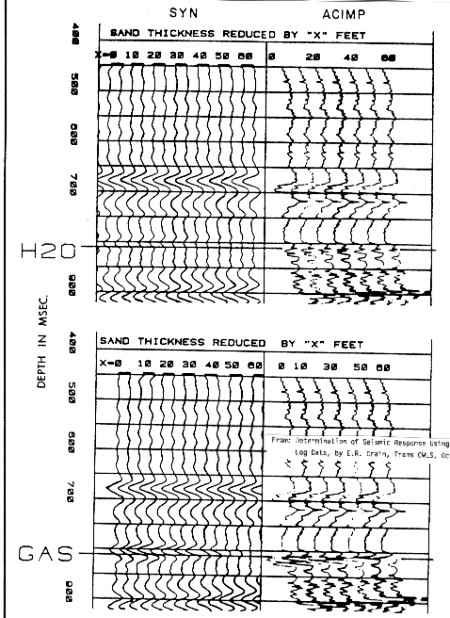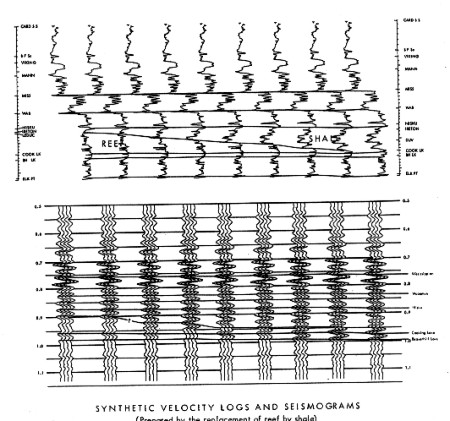|
 FLUID and Layer REPLACEMENT MODELS
FLUID and Layer REPLACEMENT MODELS
This Section contains case
histories with a fluid or rock layer replacement component and illustrates
the dramatic effect of gas on the seismic signal. Refer to
other Sections of this Chapter for the mathematical details.
 Case History
- Swan Hills Reef
Case History
- Swan Hills Reef
This is a Swan Hills reef section in the Rosevear area of Alberta
with significant gas filled porosity. The log segment shown
below contains the
log analysis results and seismic results (acoustic impedance and
reflection coefficients) on a highly compressed depth scale. Formation
tops are shown and the modeled interval is marked.

Reflection coefficient, acoustic impedance,
and log analysis before and
after gas model - depth scale

Seismic traces, acoustic impedance, and log
analysis before and after gas model - time scale
The
model merely replaced the mud filtrate seen by the logs with a
mixture of gas and formation water. The model results are shown on a two
way time scale. The shaded area on
the acoustic impedance curve shows the difference between log
recorded values and the modeled values. Reflection coefficients
and peak amplitude on the synthetic are about 40% higher after
modeling. The modeled values more closely represent the formation
as seen by the seismic impulse, and this is confirmed by the actual
seismic data.
This
example prepared by the author and published in "Determination
of Seismic Response Using Edited Well Log Data" by E.R. Crain
and J.D. Boyd at CSEG Annual Symposium, October 1979. The model
uses the log response equations for sonic and density data and
a pseudo-travel-time for gas. The pseudo travel-time method may
over estimate the gas effect, but this can be controlled by reducing
the gas effect to match the real seismic reflection amplitude.
The
bright spot caused by the gas is a characteristic of some reefs
in this area. It is interesting to consider what the reflection
would be like if the porosity was at the top of the reef instead
of in the middle. The acoustic impedance of the gas filled porosity
is almost the same as the overlying shale.
There
would be no reflection at the top of the carbonate, and the base
of the porosity would be mapped as the carbonate top. Such cases
undoubtedly exist and models clearly demonstrate why they might
not be found by seismic interpretation.
 Case History - Gas and Water Sand
Case History - Gas and Water Sand
The second example illustrates a synthetic seismic section derived
from a single well in the Canadian Arctic Islands. The well contains gas
in a thick porous sandstone. The object of the model section was
to determine if water bearing sands could be distinguished from
gas sands, and what critical sand thickness was required before
the interpreter could be sure that the sand was present.

Seismic model comparing gas and water bearing
sands of different thicknesses
Since
the geology of the area, as well as log character, suggest that
the sand is eroded from the top at an unconformity, we selectively
removed 10 feet at a time from the top of the sand and made a
synthetic trace for each case. Both a water and a gas model were
used. The sand was originally 80 feet thick.
The
sand being modeled is between 810 and 830 milliseconds. It is
evident from these plots that a gas sand 40 feet thick gives rise
to about the same seismic response as an 80 foot water sand, and
that no seismic event can be expected if the sand is wet and less
than 60 feet thick, or gas bearing and less than 30 feet thick.
These results are corroborated by the seismic data and other wells
in the area.
Prior
to making these models, two dry holes had been drilled based on
bright spot analysis on seismic sections. The abandonments cost
$15,000,000 each in 1977 dollars. After the models were made,
it was clear that bright spots were not sufficient criteria for
defining gas prospects in this area, and that better geological
control was also needed.
Many
more models could be made, and often are made, during the course
of a project. Various wavelets at varying frequencies are often
needed to narrow down the possible choices before modeling is
even attempted. The model parameters or wavelet may have to be
adjusted to obtain a better match, and since this is a modeling
problem, there may be more than one model which will adequately
match the seismic data. This example prepared by the author in
1977 using the seismic modeling module of the LOG/MATE software
package.
 Case History - Layer Replacement on a Reef
Case History - Layer Replacement on a Reef
Modeling is not new. This example dates from 1962, and illustrates
the result of replacing shale with a reef buildup. The wavelet
is fairly low frequency by today's standards, but matched the
seismic resolution of the day.

Layer replacement in a Devonian Reef
The
reef is thinned from its maximum thickness down to zero to see
what the seismic signature looks like for each case.
We
have found in foreign work that the operators have not always
had the advantage of re-acquiring or re-processing older data,
so interpreters are obliged to use lower frequency data. It is
important to match the synthetic frequency content to the seismic
available.
|

